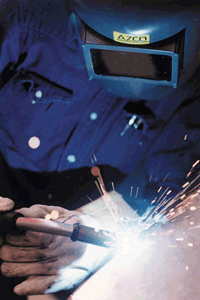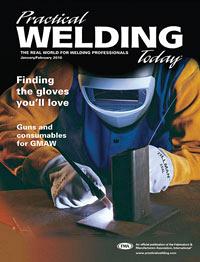Contributing Writer
- FMA
- The Fabricator
- FABTECH
- Canadian Metalworking
Categories
- Additive Manufacturing
- Aluminum Welding
- Arc Welding
- Assembly and Joining
- Automation and Robotics
- Bending and Forming
- Consumables
- Cutting and Weld Prep
- Electric Vehicles
- En Español
- Finishing
- Hydroforming
- Laser Cutting
- Laser Welding
- Machining
- Manufacturing Software
- Materials Handling
- Metals/Materials
- Oxyfuel Cutting
- Plasma Cutting
- Power Tools
- Punching and Other Holemaking
- Roll Forming
- Safety
- Sawing
- Shearing
- Shop Management
- Testing and Measuring
- Tube and Pipe Fabrication
- Tube and Pipe Production
- Waterjet Cutting
Industry Directory
Webcasts
Podcasts
FAB 40
Advertise
Subscribe
Account Login
Search
Considering the benefits of pulse spray transfer GMAW
- By Paul Niskala
- October 25, 2002
- Article
- Arc Welding
Pulse spray gas metal arc welding (GMAW) is a versatile welding process. Sometimes welding suppliers and welding managers don't want to try it, because they don't want to change the process they're using, train users, adjust welding processes, or spend money on new equipment.While any pulse spray machine can perform short-circuit transfer, each type of transfer has distinct differences and benefits.
Two Common Types of Transfer for GMAW
Short-circuit and spray transfer are the two most common types of GMAW metal transfer. In the short-circuit process, when the wire touches the base metal, it causes a short circuit. The base metal and wire become molten at the point where the wire touches the base metal, and the wire is pinched off. Spatter, in the form of round, molten balls that stick to the base metal, is a result of the sudden separation, or transfer, of the wire.
The short-circuit process can weld sheet metal and commonly is used for joining materials 1/4 in. thick or less. Its fast-freezing puddle characteristic makes welding in all positions simple.
Short-circuiting is a low-heat-input process, generally less than 20 volts and 200 amps using small-diameter welding wires no larger than 0.045 in. The short-circuit process can weld materials that fit poorly. Besides shielded metal arc welding, it's probably the least expensive GMAW process because of the low welding currents involved, which require smaller, less expensive equipment.
Short-circuit also is the most abused process because welders use it frequently for jobs that the process was not designed for, such as welding metals thicker than the process reasonably allows.
The short-circuit process is not a deep-penetrating process and is not suited for welding thick materials. It also lacks penetration at the toes of the weld, especially in out-of-position welding, causing cold laps (lack of fusion).
Disadvantages of short-circuit include excessive spatter and low deposition rates. It generally is not recommended for aluminum or other alloys, which typically require higher heat input to obtain proper fusion.
Spray transfer uses higher voltage and higher percentages of argon mixtures, 80 percent or better, mixed with carbon dioxide or small amounts of oxygen. This high-energy output causes the droplets to be very small and burn off the wire before short-circuiting occurs. This small stream of droplets creates a fluid spray, which melts the base metal. Using higher operating parameters results in deeper penetration. The biggest benefit of the spray transfer process is its ability to make high-deposition welds on thick carbon steels, stainless steels, aluminum, and other alloys using large-diameter welding wires (0.052 in. and 0.062 in.) with very little spatter and no cleanup.
By using 0.035- and 0.045-in.-dia. welding wires, you can weld a range of thinner materials with the spray transfer process. It is not recommended for metals 1/8 in. or less. Other benefits include no spatter, good fusion, a smooth bead, and weld appearance
The biggest drawback of spray transfer is that it can be used only in the flat position because the puddle is so fluid. Both processes can be accomplished with a basic constant-voltage welding power source.
Manufacturers have been able to design equipment that controls the weld puddle. Amperage is pulsed from a specified high-low current at predetermined frequencies to control the puddle better and thus allow for out-of-position welding.
Is Spray Transfer GMAW for You?
As with any welding process, short-circuit and spray transfer methods of metal transfer in GMAW have their pros and cons. Pulse spray GMAW can be useful for the following reasons:
- It can weld a variety of metals.
- It has good penetration.
- It can weld a wide range of thicknesses.
- It provides good fusion at the toes of the weld.
- It can weld faster than short-circuit and globular transfer.
- It has 90 percent less spatter than short-circuit transfer.
- It can be used to weld in all positions.
- It reduces the number of ASME and AWS certifications required.
- On the other hand, short-circuiting can be beneficial because:
- It can be used for welding sheet metal.
- It can weld materials 1/4 in. thick or less.
- It can be used to weld in all positions.
- It uses low heat input, generally less than 20 V and 200 amps, using small-diameter welding wires no larger than 0.045 in.
- It can weld materials that fit poorly.
Equipment for short-circuit welding can be less expensive than for spray transfer. Any spray machine can perform short-circuit transfer as well, but cost differences exist primarily in the type of gas used. Short-circuit uses less argon and more carbon dioxide, while spray transfer requires more argon and less carbon dioxide. Argon is one of the most expensive industrial welding gases used in GMAW, while carbon dioxide is the least expensive.
By considering the cost, the benefits of short-circuit and spray transfer processes, and your product line, you can decide the best mode of transfer for you.
About the Author
About the Publication
subscribe now

The Welder, formerly known as Practical Welding Today, is a showcase of the real people who make the products we use and work with every day. This magazine has served the welding community in North America well for more than 20 years.
start your free subscription- Stay connected from anywhere

Easily access valuable industry resources now with full access to the digital edition of The Fabricator.

Easily access valuable industry resources now with full access to the digital edition of The Welder.

Easily access valuable industry resources now with full access to the digital edition of The Tube and Pipe Journal.
- Podcasting
- Podcast:
- The Fabricator Podcast
- Published:
- 05/07/2024
- Running Time:
- 67:38
Patrick Brunken, VP of Addison Machine Engineering, joins The Fabricator Podcast to talk about the tube and pipe...
- Trending Articles
The role of flux in submerged arc welding performance

Aluminum MIG wires offer smooth feeding, reduced tangling

How welders can stay safe during grinding

Connecticut students compete in Maritime Welding Competition

Three ESAB welding machines win Red Dot Awards for product design

- Industry Events
Laser Welding Certificate Course
- May 7 - August 6, 2024
- Farmington Hills, IL
World-Class Roll Forming Workshop
- June 5 - 6, 2024
- Louisville, KY
Advanced Laser Application Workshop
- June 25 - 27, 2024
- Novi, MI
Precision Press Brake Certificate Course
- July 31 - August 1, 2024
- Elgin,



























